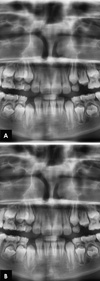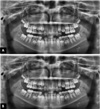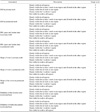1. Clark HC, Curzon ME. A prospective comparison between findings from a clinical examination and results of bitewing and panoramic radiographs for dental caries diagnosis in children. Eur J Paediatr Dent. 2004; 5:203–209.
2. Abdinian M, Razavi SM, Faghihian R, Samety AA, Faghihian E. Accuracy of digital bitewing radiography versus different views of digital panoramic radiography for detection of proximal caries. J Dent (Tehran). 2015; 12:290–297.
3. Barot AA, Chaturvedi MK, Butala PB, Rao VV, Patel PS, Barot AA. A study on changes in image quality with dose reduction in digital panoramic radiographs. J Int Oral Health. 2017; 9:174–179.
4. Sabarudin A, Tiau YJ. Image quality assessment in panoramic dental radiography: a comparative study between conventional and digital systems. Quant Imaging Med Surg. 2013; 3:43–48.
5. Peker I, Toraman AM, Usalan G, Altunkaynak B. The comparison of subjective image quality in conventional and digital panoramic radiography. Indian J Dent Res. 2009; 20:21–25.

6. Parissis N, Angelopoulos C, Mantegari S, Karamanis S, Masood F, Tsirlis A. A comparison of panoramic image quality between a digital radiography storage phosphor system and a film-based system. J Contemp Dent Pract. 2010; 11:E009–E016.
7. Amiri SA, Moudi E. Image quality enhancement in digital panoramic radiograph. J AI Data Min. 2014; 2:1–6.
8. Kandan RS, John A, Kumar S. An improved contrast enhancement approach for panoramic dental x-ray images. ARPN J Eng App Sci. 2015; 10:1897–1901.
9. Svenson B, Larsson L, Båth M. Optimization of exposure in panoramic radiography while maintaining image quality using adaptive filtering. Acta Odontol Scand. 2016; 74:229–235.

10. Baksi BG, Alpöz E, Sogur E, Mert A. Perception of anatomical structures in digitally filtered and conventional panoramic radiographs: a clinical evaluation. Dentomaxillofac Radiol. 2010; 39:424–430.

11. Gijbels F, De Meyer AM, Bou Serhal C, Van den Bossche C, Declerck J, Persoons M, et al. The subjective image quality of direct digital and conventional panoramic radiography. Clin Oral Investig. 2000; 4:162–167.

12. Choi BR, Choi DH, Huh KH, Yi WJ, Heo MS, Choi SC, et al. Clinical image quality evaluation for panoramic radiography in Korean dental clinics. Imaging Sci Dent. 2012; 42:183–190.

13. Altman DG, Machin D, Bryant TN, Gardner MJ. Statistics with confidence. 2nd ed. London: BMJ Books;2003.
14. Angelopoulos C, Bedard A, Katz JO, Karamanis S, Parissis N. Digital panoramic radiography: an overview. Semin Orthod. 2004; 10:194–203.

15. Ahmad SA, Taib MN, Khalid NE, Taib H. Correlation between quantitative and qualitative analysis on image quality of digital dental X-ray images. J Comput Sci Comput Math. 2012; 2:43–51.
16. Yalcinkaya S, Künzel A, Willers R, Thoms M, Becker J. Subjective image quality of digitally filtered radiographs acquired by the Dürr Vistascan system compared with conventional radiographs. Oral Surg Oral Med Oral Pathol Oral Radiol Endod. 2006; 101:643–651.

17. Kaeppler G, Axmann-Krcmar D, Reuter I, Meyle J, Gómez-Román G. A clinical evaluation of some factors affecting image quality in panoramic radiography. Dentomaxillofac Radiol. 2000; 29:81–84.

18. Lehmann TM, Troeltsch E, Spitzer K. Image processing and enhancement provided by commercial dental software programs. Dentomaxillofac Radiol. 2002; 31:264–272.

19. Batista SS, Panzarella FK, Tavano O, Filho AM, Junqueira JL. Image adjustments on digital panoramic radiographs using Adobe Photoshop CS3 software. Rev Sul-Bras Odontol. 2013; 10:394–401.
20. Gijbels F, Sanderink G, Pauwels H, Jacobs R. Subjective image quality of digital panoramic radiographs displayed on monitor and printed on various hardcopy media. Clin Oral Investig. 2004; 8:25–29.
21. Bekiroglu N, Mete S, Ozbay G, Yalcinkaya S, Kargul B. Evaluation of panoramic radiographs taken from 1,056 Turkish children. Niger J Clin Pract. 2015; 18:8–12.
22. Temmerman A, Hertelé S, Teughels W, Dekeyser C, Jacobs R, Quirynen M. Are panoramic images reliable in planning sinus augmentation procedures? Clin Oral Implants Res. 2011; 22:189–194.

23. Rushton VE, Horner K, Worthington HV. The quality of panoramic radiographs in a sample of general dental practices. Br Dent J. 1999; 186:630–633.

24. Kayal RA. Distortion of digital panoramic radiographs used for implant site assessment. J Orthod Sci. 2016; 5:117–120.

25. Vazquez L, Nizamaldin Y, Combescure C, Nedir R, Bischof M, Dohan Ehrenfest DM, et al. Accuracy of vertical height measurements on direct digital panoramic radiographs using posterior mandibular implants and metal balls as reference objects. Dentomaxillofac Radiol. 2013; 42:20110429.








 PDF
PDF ePub
ePub Citation
Citation Print
Print









 XML Download
XML Download